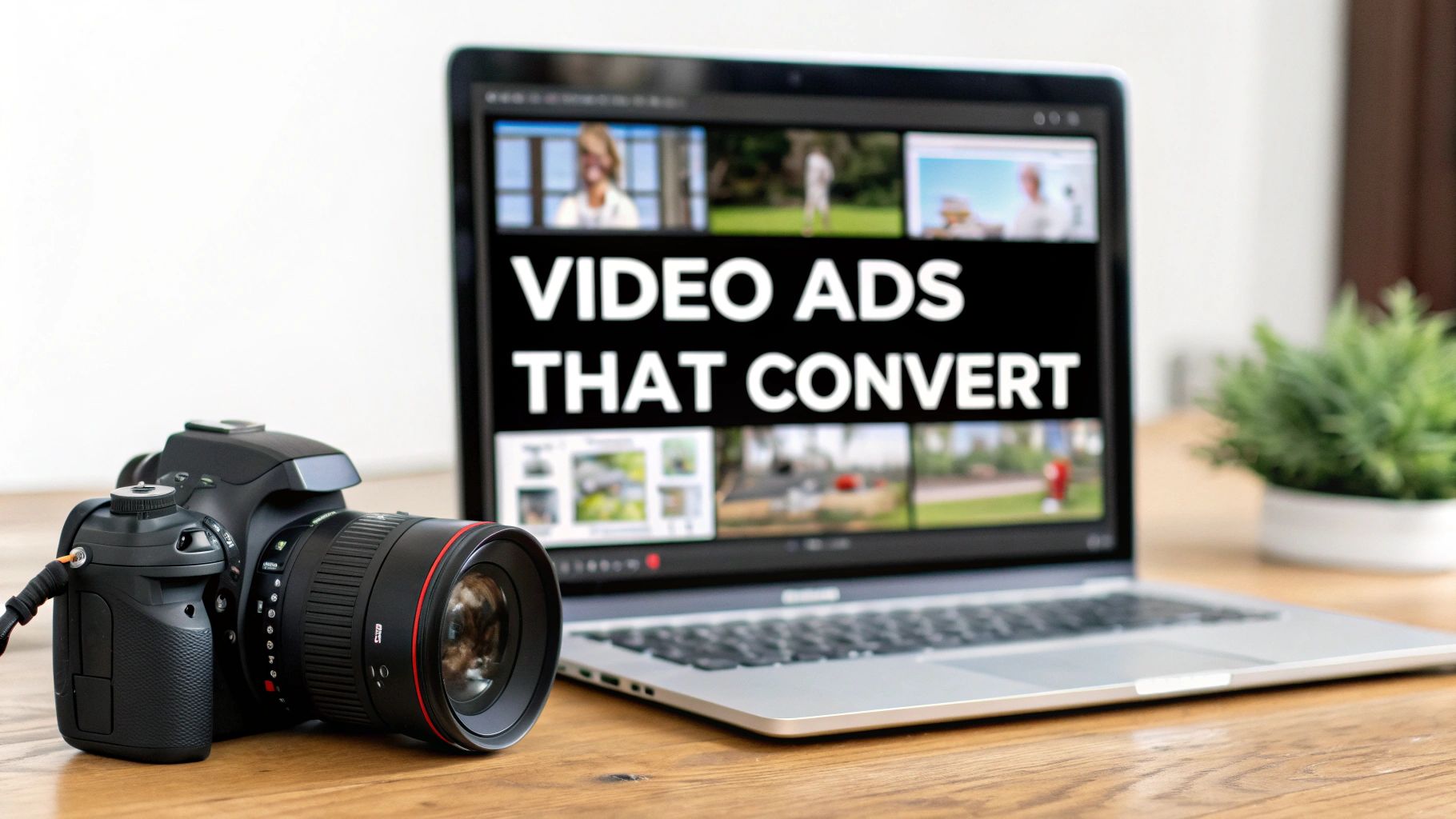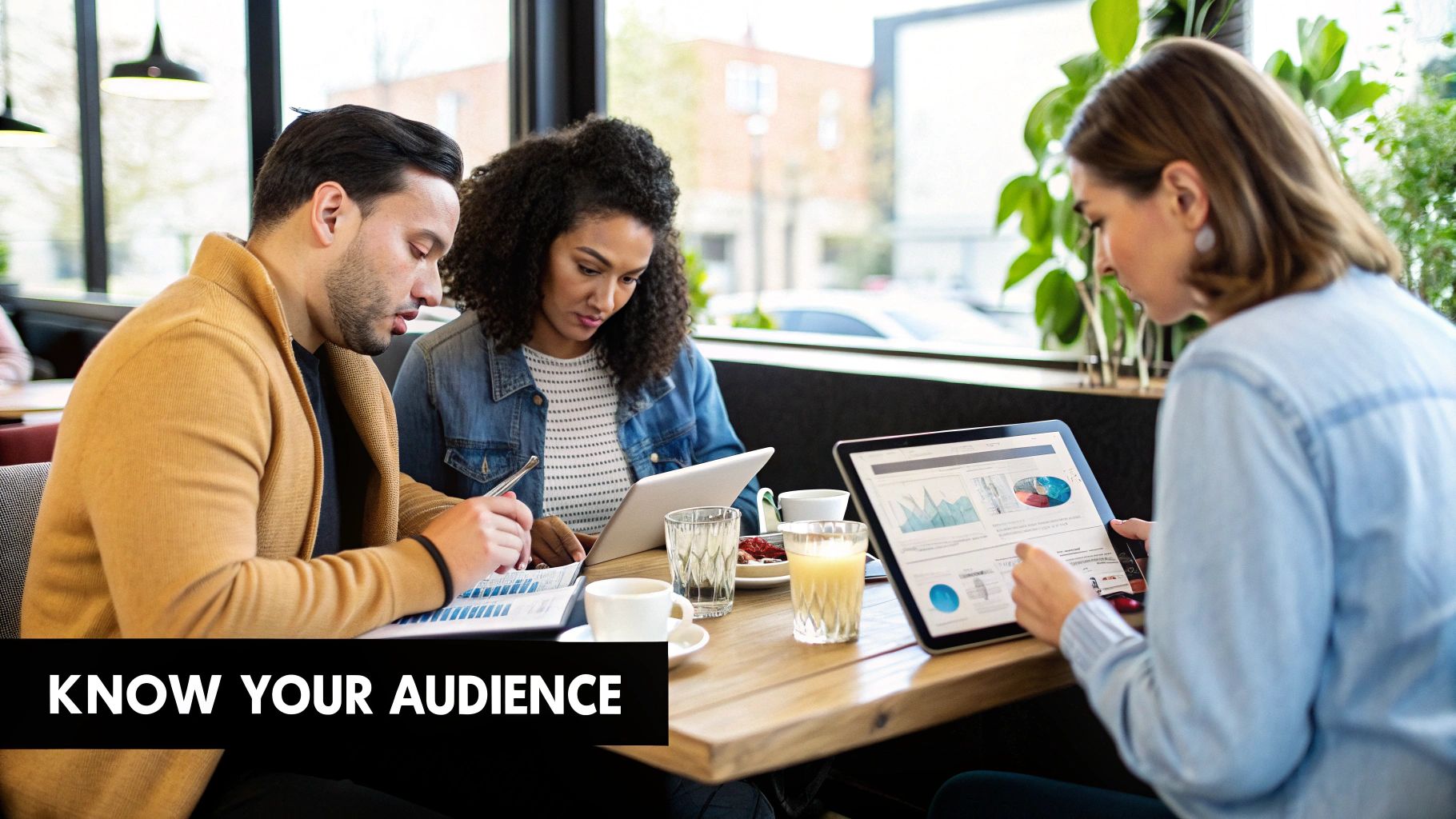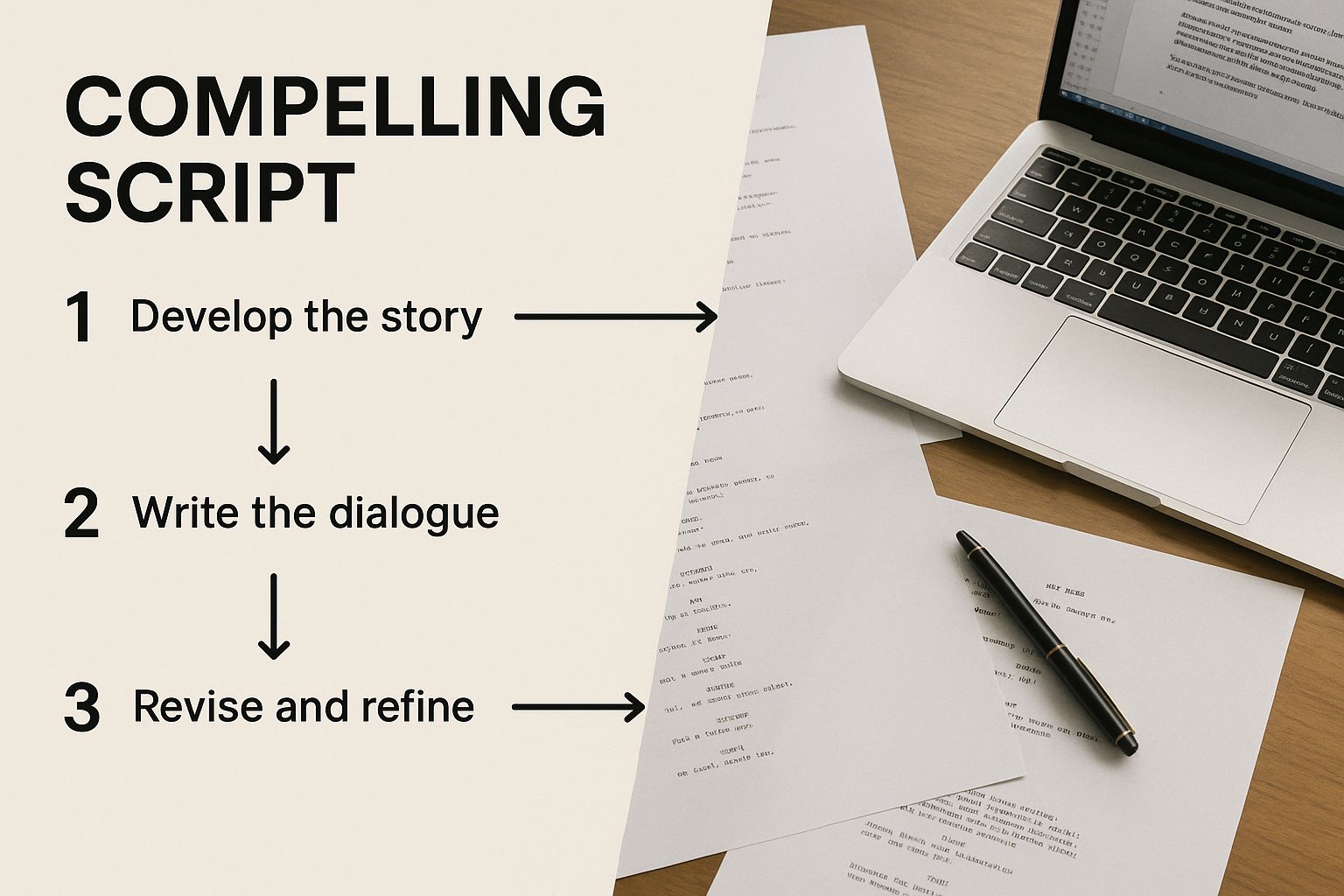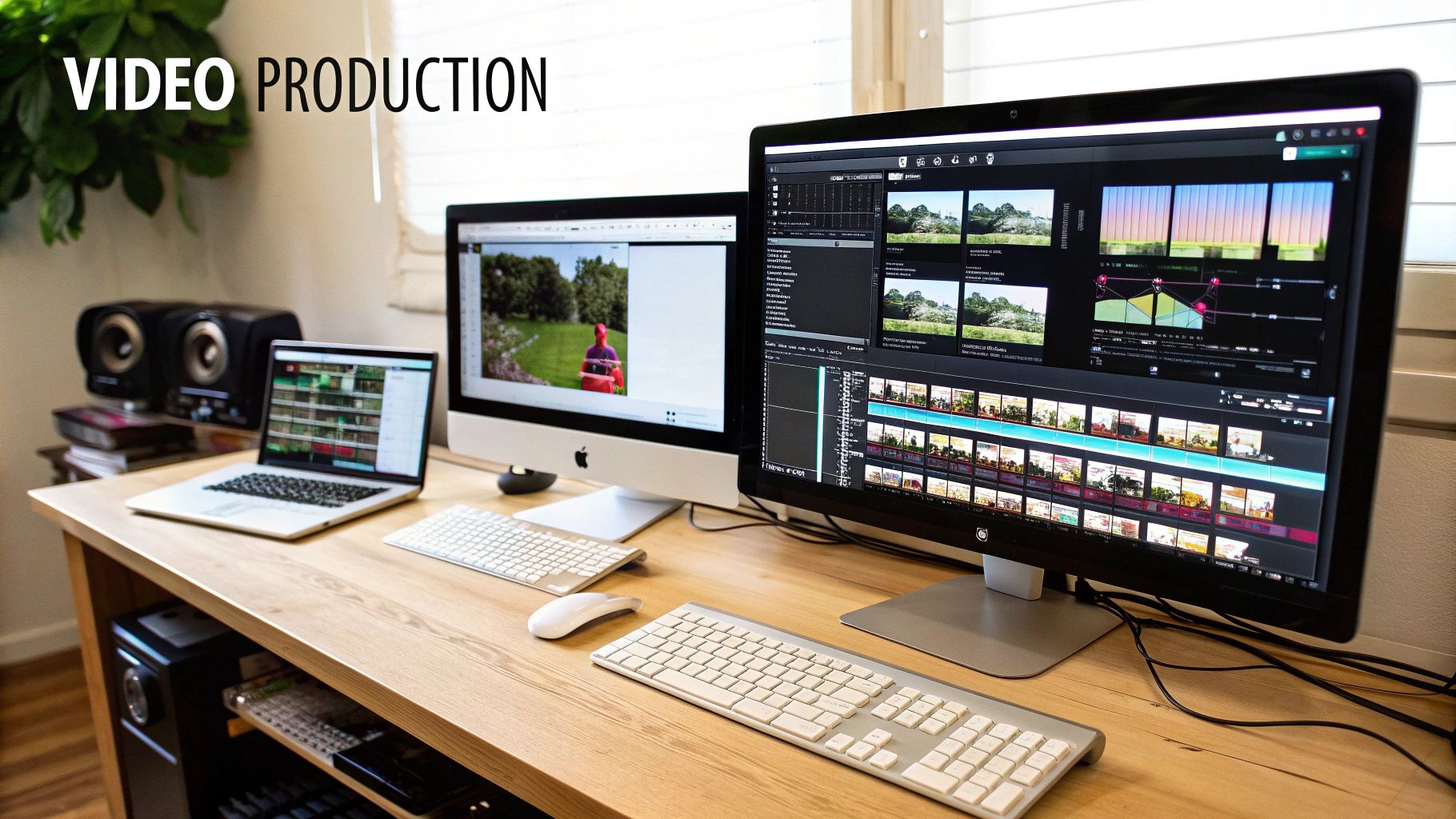
How to Create Video Ads That Actually Convert
Learn how to create video ads that capture attention and drive real results. Discover proven strategies for planning, creation, and optimization.
Look, creating video ads that actually work isn't about having a Hollywood-sized budget. It's about having a smart strategy. It all comes down to knowing why you're making the ad in the first place, planning a message that lands, and then using the right tools—like AI—to get it done fast, even if you’re no video pro.
A Quick Guide to Creating Your First Video Ad
Here’s a high-level look at the core steps we'll cover for creating a video ad that performs.
| Phase | What You'll Do | Your Main Goal | | :--- | :--- | :--- | | Strategy & Planning | Define your audience, goals, and key message. | Create a clear roadmap so your ad hits the right people with the right message. | | Production | Use AI tools to generate scripts, find visuals, and assemble the video. | Produce a professional-looking ad quickly, without needing technical skills. | | Editing & Polish | Add branding, music, and a strong call-to-action. | Fine-tune the ad to capture attention and drive conversions. | | Automation & Scaling | Set up campaigns to create variations and test what works. | Continuously improve performance and get the most out of your ad spend. |
This process gives you a repeatable framework for producing video ads that don't just look good, but also deliver real business results.
Why Video Ads Are a Must-Have in Your Marketing

Let’s get one thing straight: video advertising is no longer just another option in your marketing mix. It's become the heart of how modern brands connect with people. This isn't some passing fad; it’s a fundamental shift in how consumers watch, engage, and buy.
The days when TV commercials owned the ad world are behind us. Eyeballs have moved to digital platforms, and smart marketers are right there with them.
The Undeniable Shift to Digital
The numbers don't lie. According to the 2025 IAB Digital Video Ad Spend & Strategy Report, digital video is on track to gobble up nearly 60% of all U.S. TV and video ad budgets by 2025. That's a massive jump from just 29% in 2020, showing just how quickly budgets are fleeing old-school TV for dynamic channels like Connected TV (CTV), social media, and online video.
This isn’t just about finding a bigger audience; it’s about meeting them where they already are.
The real reason for this shift is simple: digital video gives you incredible targeting, real-time feedback, and measurement that traditional media just can't touch. You can talk directly to your ideal customer and see exactly what your money is getting you.
What This Means for Your Growth
For any brand, this shift opens up huge opportunities. Knowing how to create video ads isn't a "nice-to-have" skill anymore—it’s essential for staying relevant and growing. Whether you're trying to build brand hype on TikTok or drive sales with YouTube pre-roll ads, video gets the job done.
A well-made video can do a few key things for your business:
- Grab Attention Instantly: In a crowded feed, a moving image and sound will always beat a static post.
- Tell a Better Story: Video lets you show, not just tell. You can demonstrate your product, feature real customer stories, and build an actual connection.
- Drive Real Action: With a clear call-to-action, your video ads can send people straight to your site, fill your lead forms, and boost sales.
A solid video presence is now a non-negotiable part of any serious content strategy for social media marketing. By getting good at video, you’re not just keeping up—you're setting your brand up to win in a world that thinks, watches, and buys in video.
Laying the Groundwork: Your Video Ad Blueprint
You can’t just point a camera, hit record, and hope for the best. A killer video ad—the kind that actually makes you money instead of just eating up your budget—starts with a solid plan. This is your blueprint.
It all boils down to one simple question: What do you really want this ad to accomplish? The answer will shape every single decision you make from here on out. Are you just trying to get your name out there? Or are you aiming for direct sales on a hot new product? A brand awareness ad might tell a compelling story, while a conversion-focused ad needs to be punchy, direct, and all about the product.
Trying to build brand awareness, generate leads, and drive sales in a single 30-second spot is a recipe for disaster. It's a common trap. Stick to one primary goal. That clarity will be the North Star for your entire creative process.
Know Exactly Who You're Talking To
Once you've got your goal locked in, you need to get laser-focused on your audience. This means creating a detailed customer persona. I'm not just talking about age and location; I mean digging into their real-world problems, their motivations, and what actually makes them stop scrolling through their feed.
Let's say you're an e-commerce brand selling stylish, spill-proof coffee mugs made from sustainable materials. Your ideal customer might be "Eco-Conscious Commuter Chloe," a 32-year-old professional living in the city. She's busy, values quality and sustainability, and is fed up with flimsy travel mugs leaking all over her bag. Even more, she feels a pang of guilt every time she uses a disposable cup.
See the difference? Now you’re not just selling a mug. You're selling Chloe a stress-free commute and a way to live up to her values. That’s how you make an ad that connects.
Scripting Those First Three Seconds
Alright, you know your goal and you know who Chloe is. Now it’s time to write the script, and the most important part is the hook. You have about three seconds—max—to grab someone's attention before they're gone forever. If your opening is weak, the rest of your brilliant ad doesn't stand a chance.
For our coffee mug brand trying to catch Chloe's eye, here are a few hook ideas:
- A Visual Gut-Punch: A dramatic, slow-motion shot of a cheap travel mug toppling over and drenching a laptop in coffee.
- The Relatable Question: Flash a text overlay that says, "Tired of this?" right as the coffee spill happens.
- A Bold Statement: Open with a confident voiceover: "Your morning commute is chaotic enough. Your coffee mug shouldn't add to it."
After you've hooked them, your script needs to move fast. Present the problem (leaky, wasteful mugs), introduce your mug as the perfect solution, and finish with a crystal-clear call-to-action (CTA). Something as simple as "Shop Now and Save 20%" tells them exactly what to do next. Sketching this out in a simple storyboard will help you make sure the visuals flow and hit all the right notes.
Creating Your Video Ad with AI Tools
With your plan locked in, it’s time to actually make the video. This is the part that used to feel intimidating, right? It meant expensive cameras, complicated software, and a whole lot of time. But AI tools have flipped that script entirely. Now, you can spin up a professional-looking ad from a simple line of text or even by just dropping in a link to a blog post.
This is where a platform like ViewPrinter really becomes your secret weapon. Think of it less as a tool and more as a creative assistant that does the heavy lifting. You bring the idea, and the AI handles the production, turning your strategy into a polished video in minutes.
From Text to Video in a Flash
It all starts with your prompt. Let's go back to that spill-proof coffee mug we talked about earlier. Instead of storyboarding for hours, you could just type something like:
"Create a 30-second video ad for a durable, stylish, eco-friendly coffee mug. Show how its spill-proof design is perfect for busy commuters who care about the environment."
That's it. The AI takes that simple instruction and runs with it. It will generate a full script—complete with a hook to grab attention, a clear problem/solution flow, and a strong call-to-action. At the same time, it digs through huge libraries of high-quality stock footage to find visuals that perfectly match the script’s vibe.
The first draft it spits out is usually pretty impressive on its own, but the real magic happens when you start to refine it.
Fine-Tuning Your AI-Generated Ad
The AI gives you a fantastic starting point, but you’re the one who adds the final polish that makes the ad truly yours. The interface is built to be intuitive, so you can easily jump in and tweak every little detail until it feels just right.
You have total control over things like:
- Branding: Pop in your logo and set your brand colors. This ensures every second of your video screams your brand, not someone else's.
- AI Voiceover: Don't like the default voice? No problem. You can browse through tons of natural-sounding AI voices—different accents, genders, and tones—to find the one that perfectly fits your brand's personality.
- Visuals: You can easily swap out any AI-chosen clip for another one from the library or, even better, upload your own product photos and videos for a more authentic touch.
- Pacing: Want a scene to linger a bit longer? Need to speed up the intro? You can adjust the timing of each clip to get the rhythm just right, making sure your most important messages land with impact.
The script is what holds it all together. It's the blueprint that guides every other creative choice the AI makes.

This image really drives home the point: a solid, well-thought-out script is the foundation. It dictates the visuals, the voiceover, and the overall flow of your ad. Get the script right, and everything else falls into place.
My Advice: Never just take the first AI draft and run with it. Treat it as a high-quality head start. Spend an extra five minutes tightening the script, swapping a couple of video clips, and maybe trying out a different voiceover. That little bit of hands-on effort can take an ad from good to unforgettable.
This kind of rapid-fire creation and editing is a game-changer, especially for platforms that demand a constant stream of fresh content. If you want to get more specific, our guide on building a winning TikTok content strategy is a great next read.
Refining Your Ad with a Human Touch
AI tools like ViewPrinter are incredible for getting you 90% of the way to a killer video ad. It handles the heavy lifting, saving you a ton of time. But that last 10%? That's where you come in. This is where a human eye and a little creative polish can turn a good video into a high-converting machine.
This final step isn't about starting over. It's about the small, strategic tweaks that make your video connect with people. Think of it as enhancing the clarity, tightening the pacing, and dialing up the emotional impact. These are the details that separate an ad people scroll past from one that actually drives sales.
Mastering Pacing and Audio
First up, let's talk about pacing. Watch the AI-generated cut and ask yourself: does it flow? Are there any awkward pauses or scenes that feel like they're dragging their feet? Go through the timeline and be ruthless. Trim the fat. Shaving off even half a second from a clip can make the whole ad feel sharper and more professional.
Next, put on your headphones and focus on the audio. An AI voiceover might sound clean, but you need to make sure the background music is supporting it, not fighting it. Nudge the music volume down so it sets the mood without drowning out the actual message. A clean audio mix is one of the fastest ways to give your ad a polished, professional feel.
Your ad’s pacing and audio are its heartbeat. If the rhythm is off, viewers will feel it and scroll away. The goal is to create a seamless experience where the visuals, voiceover, and music work together in perfect harmony.
Making Your Message Impossible to Ignore
A huge number of people watch social media videos with the sound off. You have to plan for this. This makes bold, easy-to-read text overlays an absolute must. Use them to hammer home your key selling points, highlight a special offer, or spell out your call-to-action (CTA).
Speaking of the CTA, make yours impossible to miss. The end of your video needs to tell the viewer exactly what to do next, whether it’s "Shop Now," "Learn More," or "Download Our App." Use both your voiceover and a text overlay to reinforce this final command.
A few final tips to really make your ad pop:
- Design for Silence: Always add captions or burned-in subtitles. This makes your ad effective even when muted and improves accessibility.
- Get Real: If you have it, swap out some of the AI-generated stock clips for authentic user-generated content. Check out our guide on how to create UGC content for some practical advice.
- Add Visual Flair: Don't be afraid to add simple animations or graphic elements to make key moments or text stand out from the background.
This level of detail is more critical than ever. A 2025 survey revealed that while 89% of businesses now use video marketing, a staggering 37% of those who don't feel stuck on where to even begin. AI tools, especially for auto-generating captions, are now used by 18% of businesses to get over these hurdles and make video a cornerstone of their strategy.
Optimizing Your Video for Every Platform

Okay, you’ve polished your masterpiece. The editing is done. But don't pop the champagne just yet. Creating the ad is only half the battle; how you deploy it across different platforms is what separates the winners from the wasted ad spend.
A one-size-fits-all approach is a recipe for failure. The exact same video that gets incredible engagement on YouTube can completely bomb on Instagram. Each platform is its own world with its own rules, user behaviors, and technical specs.
This is why you have to get granular with platform-specific optimization. It’s all about adapting your core creative to meet your audience where they are, in the format they actually want to see.
Tailoring Your Ad for Maximum Impact
Put yourself in the user's shoes. Someone settling in to watch a YouTube video is in a different headspace than someone speed-scrolling through TikTok. On YouTube, a 60-second, landscape (16:9) ad can work beautifully. Your audience is captive and more open to a story.
Now, picture someone swiping through Instagram Stories. They're in rapid-fire consumption mode. You need a snappy, 15-second vertical video (9:16) that grabs them instantly. Anything longer feels like an interruption.
To get this right, you’ll need to create different cuts of your ad.
- YouTube: This is home for your longer-form ads (30-60 seconds) in the classic landscape (16:9) format. Go ahead, tell a more detailed story here.
- Instagram & TikTok: Think short, punchy, and vertical (9:16). Keep it under 30 seconds. Honestly, the first three seconds are all that matter.
- Facebook Feed: You’ve got more flexibility here. Both square (1:1) and vertical (4:5) formats do well because users expect a mix of content in their feed.
A word of warning: don't just crop your landscape video and call it a day. A properly optimized vertical ad means completely rethinking your shots. You need to make sure key visuals are centered and that any text overlays aren't blocked by the platform's own UI elements like the username or captions.
Crafting Compelling Copy and Thumbnails
Your video is the star of the show, but it can’t succeed without a strong supporting cast—that’s your ad copy and thumbnail. The copy needs to be short, sweet, and directly support the video's message. And always, always end with a clear call-to-action.
The thumbnail is your video’s first impression. It’s the single most important factor in getting someone to stop scrolling and actually click play. Use bright colors, human faces, and text that creates curiosity. A great thumbnail instantly answers the viewer's silent question: "Why should I watch this?"
Using Data to Drive Your Decisions
Optimization isn't a one-and-done task; it's a constant feedback loop fueled by data. Don't just launch your ads and cross your fingers. You need to be running A/B tests to systematically figure out what your audience truly responds to.
Here are a few simple A/B tests to get you started:
- Test Thumbnails: Run the same ad with two different thumbnails. See which one gets a better click-through rate (CTR).
- Test Ad Copy: Use the same video and thumbnail, but try two different hooks or calls-to-action in your copy.
- Test Hooks: Edit two versions of your video with different opening scenes. The goal is to see which one gets a higher View-Through Rate (VTR).
Tracking these metrics isn't optional. Your VTR tells you if your video is engaging, while your conversion rate tells you if it's actually driving sales. These numbers are the feedback you need to make smart, data-backed decisions with your ad budget. The goal is to continuously refine your approach so every dollar works as hard as it possibly can.
The impact here is massive. Looking ahead to 2025, 88% of marketers already say video helps them generate leads, and 84% report that it has directly boosted sales. With video projected to make up 82% of all internet traffic this year, mastering these optimization techniques is non-negotiable. You can dig into more of these powerful video marketing statistics on Teleprompter.com.
Of course. Here is the rewritten section, crafted to sound like it was written by an experienced human expert.
Your Video Ad Questions Answered
Even with the best plan in place, it’s completely normal to have a few questions rattling around your head. I get it. Creating video ads can feel like a big undertaking.
Let’s tackle some of the most common questions I hear from marketers just like you. My goal here is to give you clear, no-fluff answers so you can move forward with confidence.
How Much Should a Video Ad Cost?
This is always the first question, and the honest answer is: it depends. There’s no magic number. Your budget is tied directly to what you’re trying to achieve.
Are you just trying to get your brand name out there on TikTok? You could probably start seeing some initial traction and testing the waters with just a few hundred dollars. It’s a great way to dip your toe in without a huge commitment.
But if you’re running a serious campaign to drive sales on a platform like YouTube or Facebook, you’ll need a bit more firepower. I usually recommend a starting test budget somewhere in the $1,000 to $3,000 range. That’s enough cash to run meaningful A/B tests, gather real data, and figure out what’s actually working before you start pouring more money into it.
My Advice: Start small, measure everything, and let the data tell you where to double down.
What Is the Best Length for a Video Ad?
There’s no one-size-fits-all answer here. The perfect length is all about the platform and your specific goal.
Think of it this way:
- TikTok & Instagram Reels: Go short. Really short. You have about three seconds to grab someone, so aim for under 30 seconds total.
- Facebook & Instagram Feed: You get a little more breathing room here. Anything from 15 to 60 seconds can work well if the content is solid.
- YouTube: For those pre-roll ads everyone loves to skip, 15 to 30 seconds is the sweet spot. If you’re doing a longer, story-driven ad or a tutorial, you can go longer, but you’d better make sure every second is compelling.
The most important thing to remember? Get your main point across immediately. Assume most people won't watch to the end, so deliver your core message right at the beginning.
Can I Really Make Good Ads Without Being a Video Expert?
Absolutely. One hundred percent. The days of needing a film degree and a truckload of expensive gear are over.
AI tools are no longer a futuristic concept; they're practical assistants. They can handle the heavy lifting—generating scripts, sourcing visuals, and even adding a professional-sounding voiceover. You bring the strategy and the core idea, and the AI helps you bring it to life quickly.
We’re even seeing platforms like Amazon roll out AI generators that can spin up a surprisingly realistic video from a single product photo. This tech isn’t just for big corporations anymore; it’s here to help you create great-looking ads without the massive learning curve.
Ready to stop wondering and start creating? With ViewPrinter, you can turn your ideas into high-converting video ads in minutes. Our AI-powered platform gives you everything you need to generate scripts, find visuals, and launch campaigns that drive real results. Start creating your first video ad for free today.